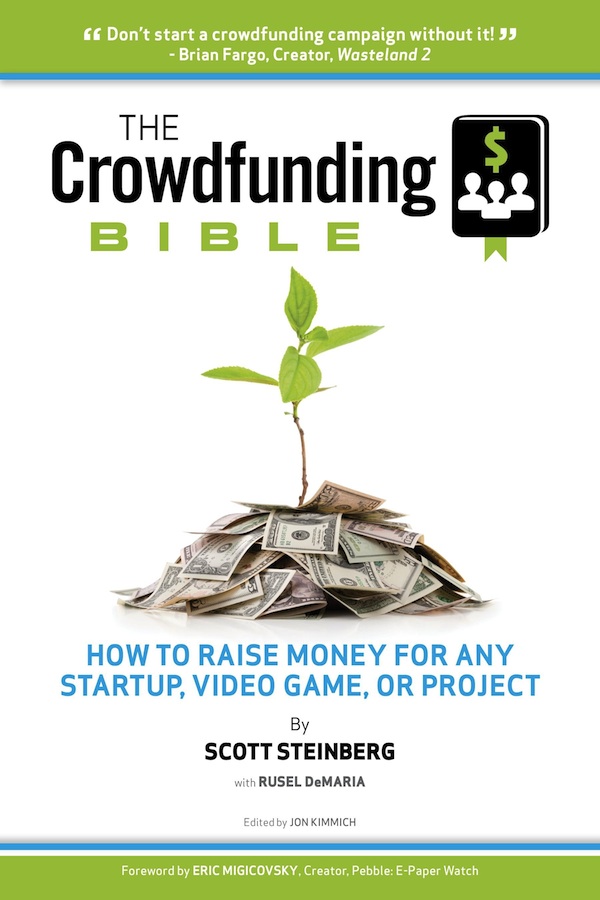The following is an excerpt from Scott Steinberg’s new book, The Crowdfunding Bible. The book is free to download at www.CrowdFundingGuides.com, or in e-book form on Apple, Nook and Sony Reader devices.
Crowdfunding, hailed by many as a better approach to venture capital and angel investment, hasn’t been lacking for attention lately. Thanks to the multimillion-dollar success of campaigns like the Pebble E-Paper Watch, Double Fine Adventure and Shadowrun Returns, millions of startups and entrepreneurs are now contemplating turning to the Internet to raise money online. Just one problem for both them and the many small businesses and services hoping to capitalize on the practice’s newfound success in the wake of the JOBS Act’s newer, more open-ended investment regulations. As today’s most accomplished creators will tell you, turning to the Internet and everyday end-users for backing and donations isn’t a cakewalk, and nine out of ten projects get their proverbial ass handed to them.
Think you’ve got what it takes to make the best crowd funded websites and services like Kickstarter, RocketHub and IndieGogo work for your next app, consumer product, service or invention? You might want to check your ego at the account signup screen. Following are five firsthand accounts of crowdfunding ups, downs and in-betweens, including essential must-read hints, tips and advice from the experts whose advice should you most consider – those who’ve been there, done that, and successfully seen thousands, if not millions, of dollars pour into their new ventures. As for the guys and gals who didn’t, well… After reading what you’ll have to go through just to initially get projects off the ground, you’ll see why they’re just as happy to remain silent, and/or quietly let failed efforts fade into obscurity.
Scott Wilson – Founder of Design Studio MINIMAL
One of the early adopters of the crowdfunding model, Scott’s innovative design for a watchband and holder for Apple’s iPod Nano (including the TikTok and LunaTik Multi-Touch watch kits) resulted in one of the first smash successes on Kickstarter, grossing nearly $1 million in just 30 days. We talked with Scott about what it was like to be on the bleeding edge of this new form of investment.
Q. You used Kickstarter before most people even knew what it was. What led you there?
A: Rejection. I’d been working for a while on a design for a more premium watchband for the Nano (I didn’t want it to be just another rubber strap, but something that complemented Apple’s design). I showed it around to a few people, a number of companies, and they would all have initial interest, and then they’d pass. One of my friends, a former designer, had left and gone to work on Obama’s campaign as design director, and he ran a campaign on Kickstarter called Designing Obama, that had done pretty well. So that was the point I first noticed crowdfunding.
Around the time I was getting all these rejections, I also noticed that the Glif [iPhone 4 tripod mount] guys and the success they were having and I thought, “Well, why don’t I put this up there and see what happens? Otherwise this design is just going to sit in a folder on my computer and die.”
At that time, there weren’t that many products like mine to look at, so I looked at what had been done with Designing Obama and how its creator did a nice little video, as well as what others were doing, and everything seemed pretty raw, approachable and real. A lot of what we do for or design clients, well, my thinking was if I could do at least half as good as that, then that would be fine for the Kickstarter platform.
I had some rendering and the prototypes that we built, and from that we put together a video, and I would talk about my background, which I hoped would lend some credibility. Then we added an animation showing how it would fit together and some b-roll stuff from ‘behind the scenes’ making the product. I remember that it was a couple of week’s worth of work, and the guys in the office were busy and would occasionally ask, “Why are you wasting your time on all that?”
Q. Public relations and marketing: How did you handle them?
A: Pre-launch, I really only had one conversation with Fast Company in New York. Before I had even thought of Kickstarter, I’d shown them images on my phone of what I wanted to do and they fell in love with it and wanted to break the story of what we were doing. So that’s how things began.
And then coincidentally, the day before we launched the campaign, I had just hired a PR agency for the Minimal, and when she started I stepped her through all the stuff that needed doing; here’s the stuff for MINIMAL, stuff for design awards, and a bunch of other things that I don’t like to deal with, and oh, by the way there’s this Kickstarter thing tomorrow, and there may be a little bit of stuff to do there. And when it hit, it just went crazy, and she was fielding all the inquiries and also reaching out to the major blogs. She dealt with all that stuff and filtered it for me – that turned out to be great timing.
We had a pretty good idea of who we thought would be interested in TikTok: Apple geeks, watch collectors and folks like that… but what we didn’t know was how many. We underestimated how many we could reach when we connected the dots of storytelling, PR and social media, and what would happen when a viral loop established itself.
We really had no idea how well it would sell; our budget was based on covering the tooling, and a minimum order quantity that we’d have to commit to with our overseas manufacturer of maybe 5000 pieces over the course of a year. My biggest concern with the whole campaign was that we’d post it up there, but how would anybody find out about it? So I put it up the night before, maybe around midnight, and I watched it, and in the morning only one person had pledged.
Fast Company ran the exclusive the morning of the launch, and that was maybe 8:30am. Then it got a little momentum and by 5:30pm that day we were at about $6,000 and we left the office all excited because we were halfway there. I was heading to a bar to meet up with a friend, and on the way I get a text message from my wife that it was at $22,000, and I thought, “She must be looking at the wrong project.” A few minutes later I get another text that it’s at $30,000, and I thought, “What the hell?” We found out later that this was when the piece on TikTok went live on Gizmodo.
And then the email on my phone starts going nuts. “Ding, Ding, Ding da Ding.” By the end of that night, we were at close to $100,000. That was our first big spike, and then they ran a second, follow-up piece a couple of weeks later, and that was our second biggest spike. And then after something like that, people start sharing the story, social media comes into play, and it starts to feed on itself.
I’d like to say we planned it: The time of year we picked to do it, the tech blogs we reached out to, a sort of “What if we did these things, what would happen?” – but it really did take on a life of its own. The project turned out to have a much wider appeal than we thought. Different people saw different things in it, and it resonated for them. It’s a thing that’s hard to repeat, but then you see what’s happening with the Pebble Watch, and Double Fine’s adventure and how people get caught up in it… and it’s cool.
So definitely find out who the influencers are for your type of product. Especially on social networks: Who is that one person who is going to be the tipping point for you?
Q. Managing the campaign and the after-campaign process: Mind sharing how it went?
A: Ugh! It was a lot of work to manage. You definitely don’t want to underestimate maintenance and follow-up. I was pretty much dedicated from the campaign launch until the spring when we hired some folks to take it over. We actually hired some people to help me make sure that we didn’t lose any messages through the cracks as people would message and email me. I think at one point we had a total of maybe 40,000 messages to deal with and it was overwhelming. I was constantly responding to these messages and questions. It was fun, but took quite a bit of time. You’re probably going to want to recruit some help for this part.
Interestingly, one of the decisions that we made in the final week was to quickly put up a pre-order site at the end to capture some of the momentum after the campaign ended. We probably got another $70,000 preorders the day after the campaign ended, putting us over $1 million in total pledges. And that momentum really didn’t slow down much in the next couple of weeks.
Another thing that we did that was shockingly successful was to ask everybody over on our Kickstarter page to go over to our product website and sign up for the newsletter. We probably got a conversion rate of nearly 10% in just the first eight hours. It just showed how much enthusiasm the early adopters had to hear more about the project as things went on.
Q. Anything you’d do differently if you had to do it all again?
A: One of the biggest worries I had when TikTok went big was how to fulfill it globally. I was traveling in China while the Kickstarter campaign was going on and happened to post an update (shot with my iPhone and complied with iMovie – again, on my phone) and one of the biggest fulfillment guys in all of Asia saw the update (he must have been monitoring the project) and got a hold of me, “Hey, I see you’re in China, I’m sending a car to pick you up. I want to fulfill your product globally for you.” That was a HUGE relief off of my shoulders when that happened.
Don’t underestimate the execution side of things. I’ll occasionally get emails from folks who’ll say sometime like, “I successfully funded my project, but now I don’t know what to do!” Do your homework. On the bright side, when all was said and done, we shipped out 22,000 units to over 50 countries.
Q. What sort of impact did the crowdfunding campaign have for your company and project?
A: The thing I get everywhere I go, and the thing I find most rewarding when I talk to folks who’ve started their own campaigns, is “You were my inspiration to do it myself.” That will last long after the TikTok and the Lunatik are gone; when Apple has moved on and the Nano’s design is different, that source of inspiration will still be there. Obviously, Kickstarter built the platform, but I think we helped a little bit to build awareness and showed product designers that “hey, there’s something here.” It probably would have happened eventually – we just happened to be in the right place with the right product.
 Professional keynote speaker Scott Steinberg is a leading expert on leveraging new technology trends to enhance business strategy and family life. He is also a noted industry consultant and bestselling author.
Professional keynote speaker Scott Steinberg is a leading expert on leveraging new technology trends to enhance business strategy and family life. He is also a noted industry consultant and bestselling author.


